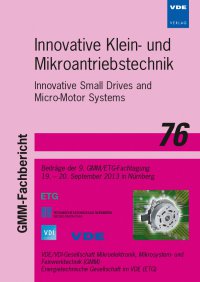Analytical Calculation Model of an Electronically Commutated Synchronous Motor Including Parasitic Effects
Conference: Innovative Small Drives and Micro-Motor Systems - 9. GMM/ETG-Fachtagung
09/19/2013 - 09/20/2013 at Nürnberg, Deutschland
Proceedings: Innovative Small Drives and Micro-Motor Systems
Pages: 6Language: englishTyp: PDF
Personal VDE Members are entitled to a 10% discount on this title
Authors:
Hartmann, Alexander K.; Gottkehaskamp, Raimund (Arbeitsgebiet für Elektrische Maschinen und Theoretische Elektrotechnik, Fachhochschule Düsseldorf, Germany)
Abstract:
A calculation model is presented which describes the stationary operation behaviour of an electronically commutated synchronous motor, including its parasitic effects. This model is valid for permanent magnet motors, separately excited synchronous motors, and synchronous reluctance motors. The magnetomotive Force (MMF) of the air-gap is generated by thread-like surface currents placed on the surfaces of the stator and rotor. This induces a radially extending, one dimensional air-gap field. Permanent magnets are modelled by the use of magnetization current densities. The air-gap field modulation of a real synchronous motor caused by the stator slots and pole gaps of the rotor is taken into account via permeance waves. The MMF multiplied with the permeance waves of the stator and rotor yields modulated magnetic flux density waves. This concept also allows calculation of position-dependent inductances. A virtual displacement method is used to calculate the torque of the motor. It allows calculation of reluctance and cogging torques as well as torque ripple. The analytical model is verified by comparing its results to numerical finite-element method calculations.


